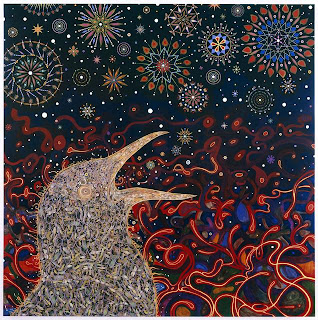I am continuing to read Aesthetics and Painting by Jason Gaiger. I am on the third chapter, called Surface and Subject which begins with an introduction to how painting can be seen and analyzed. He uses the image below to describe his ideas. The first way to see or describe this piece, Giager says, is to observe it as “a series of marks on a flat surface.” This is accurate, but too shallow of a description, so he goes further to say that we could also analyze it in terms of what we see, such as the form of the seat supporting the woman, the white dress she wears, the metallic-gold quality of her binoculars, the position of the viewer: above and to the right, and the beige background with a simple shadow under the woman.
Gaiger says the reason why he uses this image as an example is because it is easy to distinguish in it the difference of these two forms of perception. Here's where the philosophical thinking comes in. He says on page 39, " Both seem to be necessary to depiction. For unless you were aware that you were looking at a marked surface, you would not be aware that you were looking at a picture; and unless you were aware that the experience of looking at the picture is in some way like the experience of looking at its subject, you would not be aware of what it represents." Having made this distinction, he asks how these two ways of seeing are related to each other. "How does our visual awareness of the drawing as a physical object with a discrete set of properties enter into or inform our awareness of what it represents?" Jeesh, Heavy stuff : p Essentially he is asking the question of how me knowing it is a painting affects the way I see the painting.
Adolf Menzel's Lady with Opera Glasses from 1850
Giager brings a book, written in 1960 by Ernst Gombrich, called Art and Illusion, into the conversation, but more on that later.
I am learning all sorts of techniques in this awesome painting class. It almost makes taking French bearable. Our next project is to paint the nude from life. In the past, I have had a lot of trouble with capturing skin tones. I tend to use too many greys, making the figures look zombie-ish. One of the most awesome tools my teacher Hollis has given me is a pallet of compatible skin tones. This knowledge is carrying over to every piece of art I am working on right now, which is a lot, by the way.
I am researching different artists so that they might help guide me through the process. Jenny Saville (1970-) is a contemporary British painter; best known for her large-scale paintings of women. I enjoy the skin tones she uses. They are vibrant and realistic.
Andrew Newell Wyeth (1917–2009) was an American realist painter. I've been studying his Helga paintings from the 80's which are amazing. Close inspection of these pieces reveal many abstracted colors and shapes to create a very life like image. There are dots of pure cobalt and green in the skin tones when looking closely, but pulling back a step, all of these seeming abstractions form a thoughtful and alive reality.
Here is another in-progress image of my self portrait. Photoshop has been a useful tool for comparing the reference to the painting.
Jeesh, I am still so far from being done.
Here is an example of how useful Photoshop is. I copy and paste certain problem areas side by side so that I can stare at them until I figure out what's wrong. Like here, the eye is shrunk down and the area on the right between the eyebrow and eye lid doesn't have enough volume as it wraps around. Geoff and I were talking about how Rembrandt would have killed for Photoshop.
Here is an in-progress shot of my still life. This was done mostly from life, but then I got desperate and took a picture. The bottom ellipse of the table-top is still way wrong, bur I'm on it.
Here is me learning how to draw with my tablet. I am getting a little better. It's frustrating because my replacement tablet for the one that broke doesn't have pressure sensitivity. It's lame, but I am working around it. When I can afford a better one, I'll be better off with the experience of drawing on a low-grade machine. It's just like learning to play on a cheap violin. When You finally get to a well crafted instrument, you sound like a pro.
Here is a design I made for my friend Joe Adler for his 11-11-11 album. I wish it was more animated. My feelings wouldn't be hurt if he used it for a poster instead of the cover : )

In other news my mother is seriously ill and it's ripping me literally in half. If any of you people who are my friends have sensed distance, this is why. I don't know what to do, but send money I don't have and hold long hours of therapy sessions with her on the phone. Her doctors are all completely incompetent due do a lack of good health care in Florida. There simple aren't the funds for the poor to get proper treatment. And I feel so inadequate to help. How shitty to have to watch my loved ones wither, while people all around me swim in wealth that they aren't grateful for. I hate that to get quality health care in America, you have to be loaded. If you are poor, you get pushed through as quickly and cheaply as possible. It makes me sick to witness this favoritism. America, you have your priorities all inside out and I am sick of it.



















